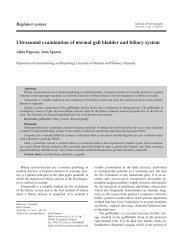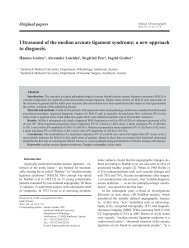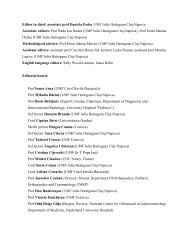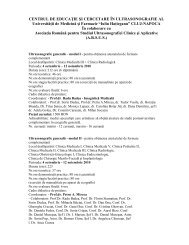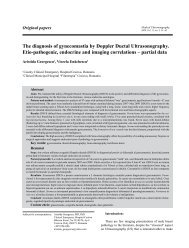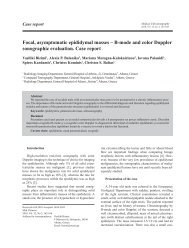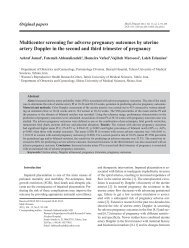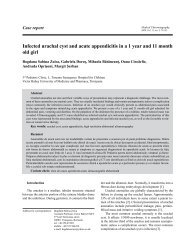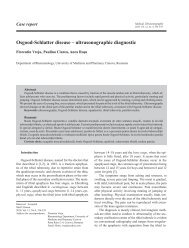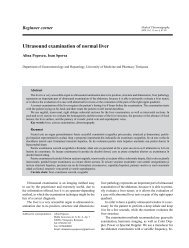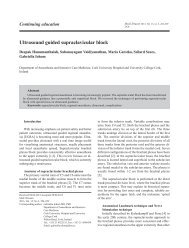Spontaneous retroperitoneal and subcapsular liver hematoma. The ...
Spontaneous retroperitoneal and subcapsular liver hematoma. The ...
Spontaneous retroperitoneal and subcapsular liver hematoma. The ...
Create successful ePaper yourself
Turn your PDF publications into a flip-book with our unique Google optimized e-Paper software.
Case report Med Ultrason 2013, Vol. 15, no. 2, 157-160DOI:<strong>Spontaneous</strong> <strong>retroperitoneal</strong> <strong>and</strong> <strong>subcapsular</strong> <strong>liver</strong> <strong>hematoma</strong>.<strong>The</strong> diagnostic contribution of CT, US <strong>and</strong> CEUS. Case report.Radu Badea 1 , Liliana Chiorean 2 , Calin Mitre 3 , Carolina Botar-Jid 4 , Cosmin Caraiani 21Ultrasonography Department, 3 rd Medical Clinic, “Octavian Fodor” Regional Institute of Hepatology <strong>and</strong> Gastroenterology,”Iuliu Haţieganu“ University of Medicine <strong>and</strong> Pharmacy, Cluj-Napoca, Romania2Radiology Department, 3 rd Medical Clinic, “Octavian Fodor” Regional Institute of Hepatology <strong>and</strong> Gastroenterology,Cluj-Napoca, Romania3Intensive Care Department, 3 rd Surgery Clinic, “Octavian Fodor” Regional Institute of Hepatology <strong>and</strong> Gastroenterology,”Iuliu Haţieganu“ University of Medicine <strong>and</strong> Pharmacy Cluj-Napoca, Romania4Radiology Department, Emergency County Hospital Cluj Napoca, ”Iuliu Haţieganu“ University of Medicine <strong>and</strong>Pharmacy Cluj-Napoca, RomaniaAbstractWe present the case of a patient undergoing long-time treatment with oral anticoagulants for a severe vascular pathologywho had a major <strong>subcapsular</strong> <strong>liver</strong> bleeding as well as <strong>retroperitoneal</strong> bleeding. <strong>The</strong> purpose of the paper is to present thespecific characteristics of this case, to review the literature that concentrates on spontaneous bleedings <strong>and</strong> to show the role ofcontrast-enhanced ultrasonography as a useful, non invasive imaging method in excluding active hemorrhage <strong>and</strong> its value inthe non-surgical management of the case.Keywords: <strong>subcapsular</strong> <strong>liver</strong> <strong>hematoma</strong>, oral anticoagulants, contrast-enhanced ultrasonographyIntroductionReceived 23.01.2013 Accepted 16.02.2013Med Ultrason2013, Vol. 15, No 2, 157-160Corresponding author: Prof Radu Badea MD, PhDDepartment of Ultrasonography,3 rd Medical Clinic, Gastroenterology <strong>and</strong>Hepatology Institute,“Iuliu Haţieganu” University of Medicine<strong>and</strong> Pharmacy,19–21 Croitorilor str400494 Cluj Napoca, RomaniaEmail: rbadea@umfcluj.roAbdominal hemorrhages have numerous causesamong which: trauma, coagulopathies, post surgical conditionsor interventional medical procedures performedeither for diagnosis or therapeutic purposes. Medicalliterature recognizes the term “spontaneous abdominalhemorrhage” as the presence of intra-abdominal blooddue to a non-traumatic, non-iatrogenic cause [1]. Abdominalbleeding due to anticoagulant treatment or hemorrhagicdiathesis (<strong>liver</strong> failure, hemophilia, idiopathicthrombocytopenic purpura, systemic lupus erythematosus)develops in various places simultaneously, arisingespecially in the abdominal muscles (rectus abdominisor psoas muscle). <strong>The</strong> abdominal organs are not involvedas often, the hemorrhage in these situations developingin the perirenal space or in the intestinal walls (mainlyjejunum) [2,3]. In patients undergoing chronic oral anticoagulanttreatment gastric <strong>hematoma</strong>s [4] <strong>and</strong> a few rarecases of bleeding within the lumen or the wall of the gallbladder have been reported [5]. Another possible bleedingsite is the retroperitoneum, which is a rare but lifethreateningsituation [6]. <strong>The</strong>re have been reported rarecases of <strong>subcapsular</strong> <strong>liver</strong> <strong>hematoma</strong>s in patients withWegener Granulomatosis [7] <strong>and</strong> post Imatinib administrationfor treatment of metastatic GIST [8].Imaging explorations have a decisive role in the detection<strong>and</strong> characterization of <strong>hematoma</strong>s [9]. <strong>The</strong> use ofcontrast enhanced ultrasonography (CEUS) as a diagnosisimaging technique on a larger scale may contribute to
158 Radu Badea et al <strong>Spontaneous</strong> <strong>retroperitoneal</strong> <strong>and</strong> <strong>subcapsular</strong> <strong>liver</strong> <strong>hematoma</strong>. <strong>The</strong> diagnostic contribution of CT, US <strong>and</strong> CEUSthe change of the therapeutic management in abdominalhemorrhages, from an invasive approach towards a nonsurgicalone, an aspect which has presented an increasedinterest in the last years [10].Case reportA 68 year old patient presented in the emergency departmentfor intense, diffuse abdominal pain, abdominaldistension, epistaxis, <strong>and</strong> bloody stools. <strong>The</strong> onset of thesymptoms had been a few days before the presentation <strong>and</strong>became more <strong>and</strong> more intense, with the peak of intensityin the day before presentation. <strong>The</strong> patient’s historyincluded a bilateral aortofemoral bypass intervention in1994 for lower limbs arteriopathy obliterans. Since thenthe patient had received chronic treatment with oral anticoagulants(Sintrom 14 mg <strong>and</strong> Acetylsalicylic Acid 40mg/day). <strong>The</strong> patient did not report any trauma or infectiousepisodes in recent history <strong>and</strong> did not use alcohol orany other drugs. <strong>The</strong> lab investigations performed in theemergency department revealed severe anemia (Hb=7 mg/dl; Ht=27%) as well as important alterations of the coagulationstatus with INR>9 (International Normalized Ratio).<strong>The</strong> abdominal computed tomography (CT) examinationperformed at presentation revealed the presence of ahypodense fluid collection surrounding the left lobe ofthe <strong>liver</strong> (fig 1a), as well as fluid in the <strong>retroperitoneal</strong>space (fig 1b). <strong>The</strong> patient was admitted into an intensivecare facility for further investigations <strong>and</strong> therapy.An ultrasound (US) examination was performed (fig 2),followed by a CEUS exam (fig 3) which confirmed thepresence of a large <strong>subcapsular</strong> <strong>liver</strong> fluid collection <strong>and</strong>a second collection, located on the inferior surface of the<strong>liver</strong> communicating with the first collection. Both fluidcollections were well circumscribed <strong>and</strong> presented a heterogeneouscontent, with membrane-like echoes inside,an aspect typical for the presence of blood clots. <strong>The</strong> <strong>retroperitoneal</strong>collection was also detected. <strong>The</strong> diagnosisof <strong>subcapsular</strong> <strong>liver</strong> <strong>hematoma</strong> (around the left lobeof the <strong>liver</strong>) <strong>and</strong> <strong>retroperitoneal</strong> hemorrhage was established,the absence of micro-bubbles inside the collectionbeing highly suggestive for inactive hemorrhage.Based on this diagnosis, plasma <strong>and</strong> blood weretransfused, resulting in a favorable evolution of the patient(within a week from admission the anemia wasresolved, the INR reached normal values <strong>and</strong> there wasremission of the clinical complaints). <strong>The</strong> follow up USexamination revealed the tendency of the <strong>subcapsular</strong><strong>liver</strong> <strong>hematoma</strong> towards organization, while the CT examshowed a reduction of the <strong>retroperitoneal</strong> fluid collection.<strong>The</strong> patient was released with an improved status withoutundergoing surgery.Fig 1. CT examination. a) Axial view, arterial phase, showinga hypodense fluid collection around the left lobe of the <strong>liver</strong>; b)3D reconstruction, coronal view, arterial phase - <strong>subcapsular</strong>fluid collection surrounding the left <strong>liver</strong> lobe <strong>and</strong> fluid collectionin the <strong>retroperitoneal</strong> space (arrow).Fig 2. Bidimensional ultrasonographic examination, transverseview: a) Subcapsular <strong>liver</strong> collection - there is an echoic sedimentationinside the collection, suggestive for blood content;b) Subcapsular <strong>liver</strong> collection <strong>and</strong> <strong>retroperitoneal</strong> collection(arrow).Fig 3. CEUS examination. a) Arterial phase - there are no micro-bubblesinside the collection; b) Portal phase - the aspectidentified during the arterial phase is also detected during theportal phase.DiscussionsSubcapsular <strong>liver</strong> <strong>hematoma</strong>s represent an accumulationof blood between the capsule of Glisson <strong>and</strong> the<strong>liver</strong> parenchyma. <strong>The</strong>y are frequently located around theright lobe (about 75 % of cases) <strong>and</strong> the rupture of the<strong>hematoma</strong> into the peritoneum is associated with a high
mortality rate [11]. <strong>The</strong> development mechanism of <strong>subcapsular</strong><strong>liver</strong> <strong>hematoma</strong>s, as well as their self-limitingcharacter is conditioned by the anatomy of the <strong>liver</strong> capsule.This is made of two layers: the first is the viscerallayer (capsule of Glisson) in close contact with the <strong>liver</strong>parenchyma, <strong>and</strong> the second is actually a reflection of theperitoneum sustaining the <strong>liver</strong> in contact with the diaphragm(hepatodiaphragmatic ligament) [12]. Since thecapsule of Glisson is fibrous <strong>and</strong> has no elasticity, theshape of the <strong>hematoma</strong> is convex towards the parenchyma,an aspect that helps to distinguish a <strong>hematoma</strong> fromother perihepatic not <strong>subcapsular</strong> collections, in whichthe shape of the <strong>liver</strong> is not modified by compression.<strong>The</strong> symptoms of <strong>liver</strong> <strong>hematoma</strong>s are not specific, thelaboratory studies reveal anemia <strong>and</strong> coagulation alterations<strong>and</strong> the final diagnosis is established through imagingtechniques (ultrasonography <strong>and</strong> CT) [1,13].<strong>The</strong> necessity of an early <strong>and</strong> accurate diagnosis in<strong>subcapsular</strong> <strong>liver</strong> hemorrhages derives from the moderntrend of treating them conservatively, especially when thepatient is hemodynamically stable [10]. <strong>The</strong>refore a lot isexpected from imaging procedures. On the CT examinationa <strong>subcapsular</strong> <strong>liver</strong> <strong>hematoma</strong> typically looks like alenticular, ellipsoid, perihepatic collection with a densitythat on the non-enhanced exam depends on the “age” ofthe <strong>hematoma</strong>. Acute <strong>hematoma</strong>s are typically hyperdense(40-60 HU), due to the high protein content. <strong>The</strong> densitydecreases in time due to the progressive lysis of hemoglobinbecoming hypodense in the chronic phase [14].<strong>The</strong> ultrasonographic appearance of <strong>hematoma</strong>s variesdepending on their localization <strong>and</strong> “age”: a recent<strong>hematoma</strong> has a fluid-like aspect, transonic <strong>and</strong>, wellcircumscribed by the capsule of the organ; there can besedimentation inside or even intense echoes generated bythe blood clots. In time, a few days after formation, the<strong>hematoma</strong> becomes echoic by condensation <strong>and</strong> theaccumulationof clots [15]. <strong>The</strong>refore, the main diagnosiscriteria is represented by changes in the aspect of thecollection from one day to another, the resorption of thecollection being influenced by the context in which thehemorrhage has occurred, comorbidities, continuous orceased bleeding <strong>and</strong> the volume of the bleeding.Regarding the evolution of the <strong>hematoma</strong>, CEUS isextremely useful as a diagnosis <strong>and</strong> follow up imagingmethod. Once the blood collection is detected, CEUShelps to better evaluation <strong>and</strong> measurement [16]. An enhancementof parenchyma that surrounds the collectionis registered during the arterial phase <strong>and</strong> the aspect persistsduring the venous <strong>and</strong> delayed phases. <strong>The</strong> methodis very sensitive in detecting active bleeding by visualizingthe echoes inside the collection as well as in detectingpossible vessels malformations that can cause the bleed-Med Ultrason 2013; 15(2): 157-160 159ing [17]. CEUS is a “real-time”, non-invasive, bedsideinvestigation that does not require radiation exposure <strong>and</strong>is an adequate choice for the evaluation of abdominalsolid organs in patients that have contraindications forCT contrast media administration or are hemodynamicallyunstable [18].<strong>The</strong>re is quite an abundance of literature regardingspontaneous hemorrhages <strong>and</strong> the value of imaging fordiagnosis. <strong>The</strong> specific features of this case are representedby the fact that a spontaneous, massive <strong>subcapsular</strong><strong>liver</strong> <strong>hematoma</strong> in a patient with an excessive intake ofanticoagulants is rare <strong>and</strong> the association with spontan<strong>retroperitoneal</strong> bleeding is even rarer. We also wantedto highlight the use that CEUS had to confirm that thebleeding has stopped. <strong>The</strong> diagnosis algorithm that wasused, based on the imaging data, led to a non-invasivetherapeutic approach. <strong>The</strong> complexity of the differentialdiagnosis must also be underlined, as the magnitude ofthe hemorrhage, both <strong>subcapsular</strong> <strong>and</strong> <strong>retroperitoneal</strong>,raised significant differential diagnosis problems, bothon the CT <strong>and</strong> US images. <strong>The</strong>refore, in this case, thecorrelation of the imaging data with the patient’s historywas very important.Conclusions: Imaging investigations allow the detectionof internal hemorrhages <strong>and</strong> help establish theorgan which is involved, the site, the extent <strong>and</strong> the evolutivefeatures of the bleeding. CEUS is useful to consolidatethe clinical diagnosis of a stopped hemorrhage.<strong>The</strong> hemorrhagic character of a fluid collection is demonstratedby observing the changes of the US aspect indynamic examination. When there is hemodynamic stabilitythe imaging data are sufficient for the diagnosis inemergency situations, making other invasive proceduresunnecessary.References1. Furlan A, Fakhran S, Federle MP. <strong>Spontaneous</strong> abdominalhemorrhage: causes, CT findings <strong>and</strong> clinical implications.AJR Am J Roentgenol 2009; 193: 1077-1087.2. Birla RP, Mahawar KK, Saw EY, Tabaqchali MA, WoolfallP. <strong>Spontaneous</strong> intramural jejunal haematoma: a case report.Cases J 2008; 1: 389.3. Zissin R, Ellis M, Gayer G. <strong>The</strong> CT findings of abdominalanticoagulant-related <strong>hematoma</strong>s. Semin Ultrasound CTMR 2006; 27: 117-125.4. Mânzat Săplăcan RM, Cătinean A, Manole S, Vălean SD,Chira RI, Mircea PA. Posttraumatic gastric wall <strong>hematoma</strong>in a patient under anticoagulant therapy. Case report <strong>and</strong>literature review. Med Ultrason 2011; 13: 165-170.5. Pilling DW. Haematoma of the wall of the gall-bladder. BrJ Radiol 1979; 52: 840-841.
160 Radu Badea et al <strong>Spontaneous</strong> <strong>retroperitoneal</strong> <strong>and</strong> <strong>subcapsular</strong> <strong>liver</strong> <strong>hematoma</strong>. <strong>The</strong> diagnostic contribution of CT, US <strong>and</strong> CEUS6. Daliakopoulos SI, Bairaktaris A, Papadimitriou D, PappasP. Gigantic <strong>retroperitoneal</strong> <strong>hematoma</strong> as a complication ofanticoagulation therapy with heparin in therapeutic doses: acase report. J Med Case Rep 2008; 2:162.7. Doganay S, Kocakoc E, Balaban M. Nontraumatic hepatic<strong>hematoma</strong> caused by Wegener’s granulomatosis: an unusualcause of abdominal pain. N Z Med J 2010; 123: 73-78.8. Shankar S. Subcapsular Liver Hematoma in MetastaticGIST Complicating Imatinib (Gleevec) <strong>The</strong>rapy. RadiologyCase Reports 2007; 2: 1 – 5.9. Lee BC, Ormsby EL, McGahan JP, Melendres GM, RichardsJR. <strong>The</strong> utility of sonography for the triage of bluntabdominal trauma patients to exploratory laparotomy. AJRAm J Roentgenol 2007; 188: 415-421.10. Van der Vlies CH, Olthof DC, Gaakeer M, Ponsen KJ, vanDelden OM, Goslings JC. Changing patterns in diagnosticstrategies <strong>and</strong> the treatment of blunt injury to solid abdominalorgans. Int J Emerg Med 2011; 4: 47.11. Ndzengue A, Hammoudeh F, Brutus P, et al. An obscurecase of hepatic <strong>subcapsular</strong> <strong>hematoma</strong>. Case Rep Gastroenterol2011; 5: 223-226.12. Lee JW, Kim S, Kwack SW, et al. Hepatic capsular <strong>and</strong><strong>subcapsular</strong> pathologic conditions: demonstration with CT<strong>and</strong> MR imaging. Radiographics 2008; 28: 1307-1323.13. Lynch J, Etkind S. <strong>Spontaneous</strong> <strong>liver</strong> haematoma as a resultof thrombolytic therapy. Gr<strong>and</strong> Rounds 2010; 10: 38-41.14. Swensen SJ, McLeod RA, Stephens DH. CT of extracranialhemorrhage <strong>and</strong> <strong>hematoma</strong>s. AJR Am J Roentgenol 1984;143: 907-912.15. Ryu JK, Jin W, Kim GY. Sonographic appearances of smallorganizing <strong>hematoma</strong>s <strong>and</strong> thrombi mimicking superficialsoft tissue tumors. J Ultrasound Med 2011; 30: 1431-1436.16. Song HP, Yu M, Zhang M, et al. Diagnosis of active hemorrhagefrom the <strong>liver</strong> with contrast-enhanced ultrasonographyafter percutaneous transhepatic angioplasty <strong>and</strong> stentplacement for Budd-Chiari syndrome. J Ultrasound Med2009; 28: 955-958.17. Badea R, Seicean A, Procopeţ B, Dina L, Osian G. Pseudoaneurysmof splenic artery ruptured in pancreatic pseudocyst<strong>and</strong> complicated by wirsungorrhagia: the role of theultrasound techniques <strong>and</strong> contrast substances. UltraschallMed 2011; 32: 205-207.18. Catalano O, Aiani L, Barozzi L, et al. CEUS in abdominal trauma:multi-center study. Abdom Imaging 2009; 34: 225-234.



